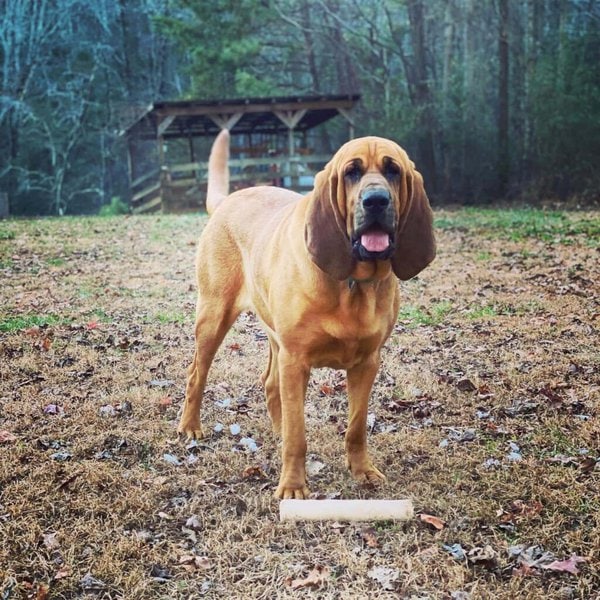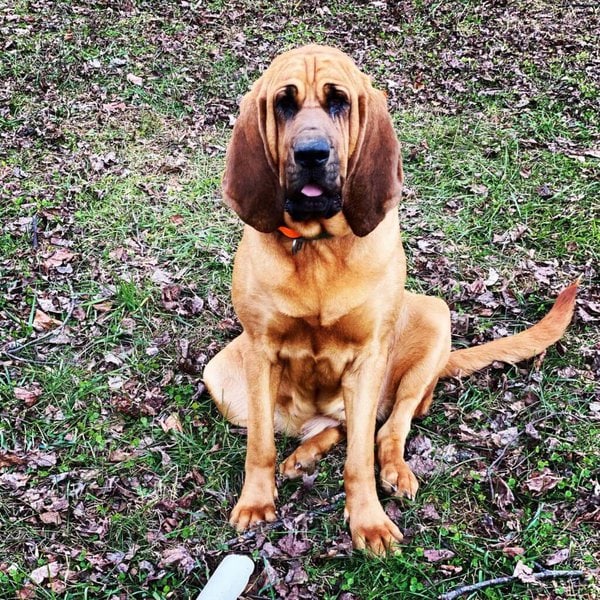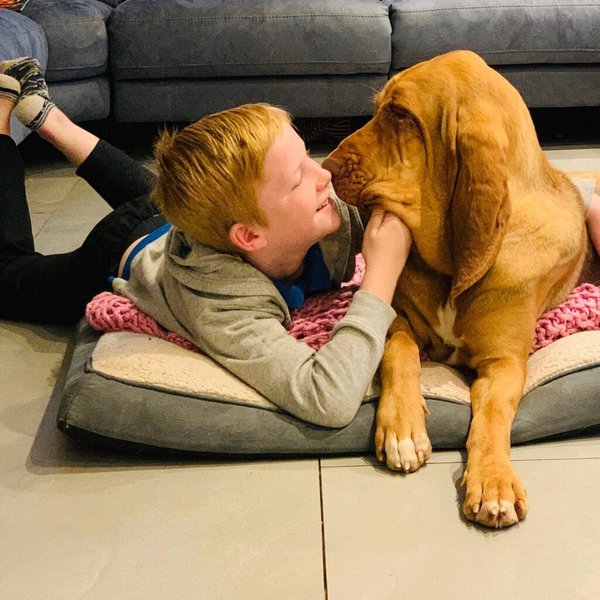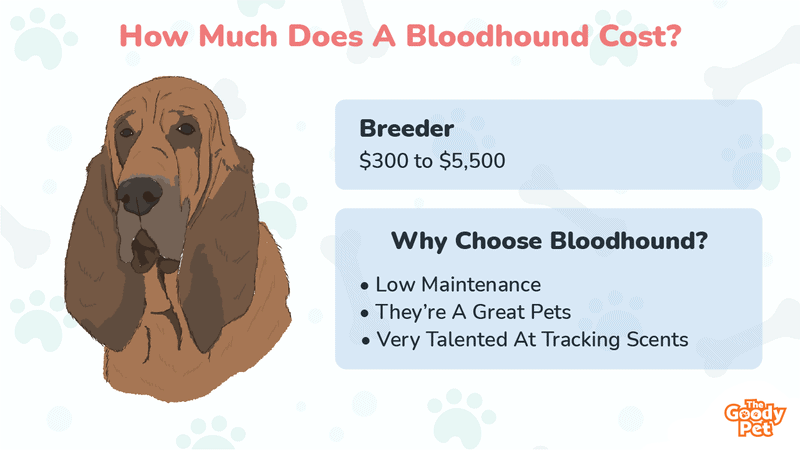The Bloodhound is widely celebrated as the best scent tracking dog in the world. These dogs truly are impressive with their sharp senses and relentlessness. For a very long time, their talents were utilized almost exclusively by hunting enthusiasts and law enforcement agencies. However, over the last few decades, these doggies have become more and more popular as companion pets and they are great at it.
Bloodhound dogs typically cost between $300 and $500. They are a common dog breed, but they can drool and bark a lot. This means that they are not as popular as some of the other breeds, so their prices are relatively low. As a hunting dog breed, Bloodhounds, as a hunting dog breed, need food and activities, so expect to spend around $150 per month on maintenance.
Bloodhounds can clearly be very expensive. Let us see why this is the case and whether or not they are actually worth it.
What’s The Average Price Of A Bloodhound?

The average price of a bloodhound is about $700.
This is actually not too bad considering how talented these dogs are and how awesome they can be as house pets. However, dogs in this price range are usually not trained and may not be from what are considered “good” bloodlines in the Bloodhound breeding business.
For a Bloodhound of high pedigree and/or professional tracking training, you will have to pay a lot more with price tags as high as $5,500 for a single Bloodhound puppy. Here is why they are sometimes so expensive and what you are getting from your investment.
Bloodhounds Make Great Pets
Bloodhounds make for great house pets whether you want a companion for your solo setup or you want a new member to add to your large family. They are quite gentle and friendly and will get along with anyone who shows them kindness and love.
Bloodhounds are also generally very easy to train and live with. This makes them not only great house pets but also worth considering if it is your first time owning a dog.
They Are Easy To Maintain
Bloodhounds are pretty low maintenance both in terms of the effort you need to put in and the yearly investment. This is another one of the main features of the breed that makes them worth the often very high price tags. The best part is that there are a lot of ways to save on maintenance costs as we will take a look at shortly.
They Are Very Talented
Whether or not you intend on utilizing the Bloodhound’s impressive scent tracking skills, it is a part of the package and you will be paying for it.
Why Do Bloodhounds Stink?

On average, Bloodhounds live for 7 to 12 years which is around the expected range for a dog that size.
They take their time to mature and are considered fully grown at around the 2 year mark. At this age, the Bloodhound should have grown to its full size weighting 80 to 120 pounds and measuring 23 to 28 inches in height
These big doggies are relatively healthy especially if you keep them well fed, active, and you keep up with routine vet visits. However, there are still a few issues that you have to look out for that may affect the dog’s quality and even length of life. Here are some of the health problems that Bloodhounds have.
Persistent Bloating
This is caused by a number of gastrointestinal issues ranging from food intolerance to gastric dilatation volvulus. While it is mostly just uncomfortable for the pooch, there is the likelihood of serious complications and should be dealt with as soon as discovered.
Hip And Elbow Dysplasia
This joint disease commonly affects large dogs like the Bloodhound and can seriously hinder mobility and activity levels. It is more common in dogs of lower pedigree as champion bloodlines have the often genetic trait selectively bred out.
Dry Eye
Bloodhounds are among some of the dog breeds known to suffer from dry eye and associated irritation. This is caused by a number of issues that affect the eye’s ability to produce lubricating liquids.
Skin Irritation
Skin issues like irritation due to heat intolerance or even allergic reactions often worsen the Bloodhound’s natural odor. The dog’s thick coat makes things even worse with the likelihood of complications like skin infections from open scratch wounds.
How To Take Care Of Bloodhounds?
We have already mentioned that Bloodhounds are pretty low maintenance. However, this does not mean that they are a hands free type of dog breed.
There is actually a lot for you to do if you want to keep your Bloodhound happy and healthy. The good news is that it is all quite easy to implement especially if you settle into a good routine with your pooch. Here are some of the most important of these care tips for a Bloodhound.
Get The Dog Plenty Of Outdoor Time
Bloodhounds are quite active and tend to get very frustrated when they are cooped up indoors doing nothing for too long. To keep your dog happy and to ensure that they stay strong and healthy, set aside about 2 hours or more every day for outdoor time whether it is a daily walk or actual playtime.
Make Sure They Are Eating The Right Food
Bloodhounds are big and active dogs and need good food to keep up with their high metabolic demands. It is important not only to get them the proper proportions for nutritional balance but also the best quality of ingredients as they tend to have sensitive stomachs.
Pet Plate is truly your best option if you want a high quality diet for your Bloodhound. The best thing about these subscriptions is the fact that they are fully customized to suit your dog’s needs.
Supplement The Diet With Multivitamins And Other Micronutrients
With issues like bone and joint diseases as well as skin sensitivity, your Bloodhound needs as much micronutrient support as possible. Supplementing their main diet with things like vitamin, mineral, and other specific bone-healing compounds is definitely the way to go.

You should also consider adding glucosamine supplements as part of their daily meal routine. This will greatly help to stem out joint problems in the future as your Bloodhound ages.
Keep The Bloodhound Cool
Bloodhounds often have a hard time regulating their temperature especially in very hot weather due to their thick coats. Find ways to keep them cool including setting up shaded hangout spots or your outdoor spaces or even investing in an inflatable pool as Bloodhounds love swimming.
Can Bloodhounds Be Aggressive? Temperament Of Bloodhounds
People often associate the Bloodhound’s history in law enforcement and military service as a sign that they are aggressive dogs. This couldn’t be further from the truth.
While a good number of military and police dogs are known for their ferocious nature, Bloodhounds are quite calm and generally unproblematic. Here is a bit more about their temperament so you see how sweet and mild-mannered these dogs are.
Loyal
Bloodhounds are very loyal to their owners and have been known to be particularly protective of young children in their human families. They form very deep, lasting bonds especially if they feel safe and cared for.
Even-Tempered
Bloodhounds truly are the most laid-back and level-headed dogs you will ever meet.
They are happy sitting back and observing and will rarely throw tantrums whether frustrated or over-excited.
They are also quite patient and tolerant of excessive handling by young children and interactions with other pets.
Affectionate And Social

Bloodhounds may be strong and independent but they definitely do not like to be left alone. The social and affectionate dog prefers the company of their favorite humans and will get sad and frustrated if left alone for too long.
Intelligent And Obedient
Bloodhounds are relatively easy to train due to a combination of personality traits including their obedience, high focus, and overall intelligence. Getting one trained professionally could cost you $250 to $500 in the first year or even more depending on the specific skill set they are learning.
You could also do the training yourself in which case we recommend you try the Brain Training for Dogs program. This offers a unique approach to dog training focusing on the breed’s mental strengths.
Do Bloodhounds Shed A Lot? Grooming Tips For Bloodhounds
Bloodhounds have very short and dense coats. They may not look like it but they actually shed moderately to heavily with the heavier shedding happening during spring and fall. Professional grooming will cost you about $300 to $400 or more every year. However, if you are willing to do it yourself you can actually save a lot of money. Here are a few tips that will come in handy in this case.
Brush The Bloodhound 3 Times A Week
This helps get rid of any loose fur and minimize shedding around the home. Due to the nature of their coats, you are better off working with grooming brushes that have short, firm bristles. You could also invest in a grooming glove for convenient and effective deshedding.
Wash Them Every 8 To 12 Weeks
Bloodhounds have a natural musk to them but you do not have to wash them more than once every 2 to 3 months. Washing them too much strips their skin and coats of protective natural oil coating leaving them vulnerable to skin irritation which just worsens the stink.
Clean Their Eyes Regularly
This helps to prevent infections especially for Bloodhounds with dry eyes and irritated corneas. Just focus on cleaning out the gunk at the corners of the eyes using eye-friendly dog wipes.
Keep Their Ears Clean And Dry
Bloodhounds have long, droopy ears that may hide a lot of nastiness and put the pooch at risk for developing ear infections. Keeping the ears clean and dry prevents this. Use a clean cloth with plain water to wipe them once every week or two and make sure to dry the ears thoroughly when you are done.
Related Questions
What Colors Do Bloodhounds Come In? By far the most common and recognizable coat color combination for the Bloodhound dog breed is Liver and Tan. The lighter, tan sections tend to be more focused around the lower regions including the lower abdomen, chest, and limbs. Other common color combinations are black and tan as well as plain red.
How Far Can A Bloodhound Smell? Bloodhounds can follow a scent trail for more than 100 miles. This impressive skill depends on a number of factors including the strength of the scent as well as the time between the scent being left and the Bloodhound starting the tracking. This skill has proven quite useful in their military and police service especially when it comes to tracking fugitives and missing persons.
Why Do Bloodhounds Drink So Much Water? Bloodhounds drink a lot of water mainly due to their very active lifestyles and their subsequent higher hydration needs. You will notice this mainly after exercise sessions. It could also be a sign of health issues including diabetes. In this case, it wouldn’t hurt to consult a vet if you notice a change in how much water they drink.





